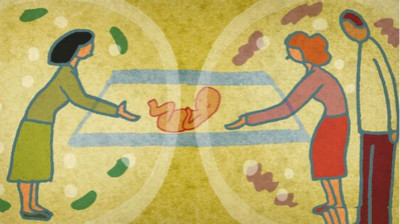Reproductive technology
生育技术
Oh, baby
噢,宝贝!
Britain's approval of babies with three genetic parents offers lessons for other countries
英国通过“三亲婴儿”决议,给他国带来的影响。
“PLAYING God” is what medicine is for. Every Caesarean section and cancer treatment is an attempt to interfere with the natural course of events for the benefit of the patient. Not every procedure should be allowed, but a general sense of what is “unnatural” is a poor guide to what to ban. Transplants and transfusions were once considered unnatural, but now save many lives. That insight is why MPs were right to agree, on February 3rd, that Britain should become the first country to allow the creation of children with genetic material from three people instead of the usual two.
医学的初衷本就是“与上帝过招”。曾经剖腹产和癌症治疗被视为是一种对病人有益但却违背自然法则的手段,可是并非每个步骤都应被人接受,在一般情况下,我们很难对于这类“非自然”的行为颁布禁令,就好比移植和输血曾一度被定为是一种“非自然”手段,然而这两种方式却拯救了无数条生命。正是有这样的见解,在2月3日,英国国会议员行使表决权,认为英国应该成为首个允许利用“一父两母”3人基因共同育子(“三亲婴儿”)的国家,从而打破传统意义上的双亲育儿。
By doing so, they hope to relieve terrible suffering. Faults with mitochondria—the tiny power sources inside cells—afflict about one child in 6,500, or 100 a year in Britain. The many conditions that result, a lot of them agonising and fatal, have no cure. So scientists hope to prevent them at conception, by transferring the healthy nucleus of an egg cell with damaged mitochondria into the body of an egg with functioning ones.
他们希望通过这样的方式来纾缓一种因线粒体疾病带来的痛苦。线粒体,作为细胞的动力工厂,却往往存在一些缺陷。在英国,大约每6500名儿童中就有一个会饱受因线粒体缺陷所带来的折磨,而这类线粒体相关疾病,每年也约有100例。多数情况下,患者多会感到极为痛苦,因无法治愈,因而多为致命的。因此,科学家们希望能在孕育期间,将捐赠者健康的线粒体与有缺陷的孕方卵子相结合来培育新的生命,以此来阻止或预防这一疾病的发生。

The procedure is not yet allowed anywhere else in the world, partly because it is new and untested in people but also because of the opposition that reproductive medicine often inspires. Mitochondria contain DNA, therefore any child born as a result of such intervention will inherit genes from three people—hence the headlines in Britain this week about “three-parent babies”. If the baby is a girl the genetic tweak in her mitochondria will be inherited by her children, and in turn by her granddaughters' children. It is a “germ-line modification”, and thus irrevocable.
这一方法尚未允许在其他国家和地区随意使用,不仅是因为这是一项新技术、尚未通过人类测试,更是因为容易激发反生殖医学派的反对。线粒体本身含有DNA,因此任何一个通过该种方式出生的孩子,都会同时继承三方的遗传因子。因此这一周英国的头条新闻均为“三亲婴儿”。如果诞生的是名女婴,那么她的基因突变的线粒体将会遗传给她的孩子,同理的,将会一直遗传给她孙女的孩子,这是一种“胚芽线式的修饰”,因此该基因无法改变。
This ethical objection to mitochondrial donation is decisively outweighed by the good that ought to come from it. Mitochondrial disease is a misery to those who have it and a terror to those who fear they might pass it on to their children; curtailing it would be wonderful. The complaint that this is the first step on the road to “designer babies” is as weak as any other slippery-slope argument: approving one procedure does not mean automatically approving others.
线粒体捐献的好处远远大于其伦理上的弊端。线粒体病给该病的患者带来深切痛苦,让他们害怕会将此病遗传给其子女,假若我们能通过“一父两母”这样的方法,解决这一问题,该有多好啊!有人指出,线粒体捐献是“设计婴儿”的第一步,但这种言论如同其它站不住脚的论调一样不堪一击,因为允许人为干预这一步骤并不意味着可以自由的发展其他步骤。
A second objection is that this procedure, like any new technique, might not be safe. Those who must bear that risk are not yet born, and so cannot consent to the treatment. But parents already make medical decisions on behalf of their children, even unborn ones. And Britain's bureaucrats, led by the Human Fertilisation and Embryology Authority (HFEA), which regulates fertility treatments, have been scrupulous in assessing risks. The HFEA first granted a research licence for the technique in 2005. Since then, a scientific panel has conducted three reviews of trials in test tubes and in animals. These have given no cause for concern.
第二个反对的声音则来自于该技术本身。毕竟作为一项新的技术,它并非足够安全。而这一次要承担风险的则是那些尚未出生的婴儿,因而有人反对采用这一治疗方式。但换言之,当今父母早就开始代表他们的孩子做出了足够多的医疗决策,当然包括他们未出世的孩子们。人类受精与胚胎管理局(HFRA)作为英国一家管理不孕不育的机构,一直引导着英国的一些政府机构谨慎的评估该风险。HFRA从2005年起,便首次颁发许可证允许开展这一技术的研究。从那时起,该科学小组就已在试管婴儿及动物身上进行了三次检验,检查结果也并未显示存在问题。
From the land of the test-tube baby
源于试管婴儿
That scrupulousness is one reason why the vote passed as easily as it did. Doctors and patients' groups sometimes criticise the HFEA for being too conservative. But its somewhat ponderous, consensus-seeking approach (the HFEA has conducted consultations, ethics reviews and several opinion polls) has helped Britain steer clear both of American-style culture wars and of the lax oversight found in some Asian countries.
英国在这一问题上始终小心谨慎是该提案得以轻松通过的原因之一,在该问题上有时医生及患者还指责HFEA在这一研究上过于保守。可是正因为这种略显迟缓、但又始终保持广征民意(HFEA多次进行了意见咨询,道德审查及民意测验)的态度,使得英国成功避开了美式文化战和一些法律监管有所疏漏的亚洲国家的反对。
Mitochondrial donation will not be the last piece of controversial medicine that the HFEA will need to wrestle with. It is already possible, for example, to sequence the genes of embryos and discard those that carry incurable genetic diseases. Choosing beneficial characteristics is, for now, illegal. But as the human genome becomes better understood, patients may agitate for exemptions. The HFEA, or something like it, offers the best method for evaluating the benefits and risks of such procedures. Sometimes bureaucrats are just what you need.
线粒体捐献虽然还饱受争议,但这仍旧不是HFEA所要面对的最后一件具有争论性的医学技术问题。例如,现今的医学水平已能对胚胎基因进行排序,甚至剔除那些不可治愈的基因性疾病的基因。虽然,目前人为地选择有益基因是违法的,但是随着人类对自身基因的不断研究和深入理解,患者或许会产生对撤销这一法律规定的诉求,那时HFEA及其类似机构则应为这些医学技术及步骤进行深入的利弊评估,服务民众本就是政府机构的职责所在。翻译:杨霭琳
译文属译生译世












